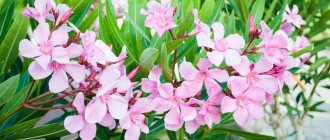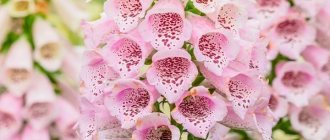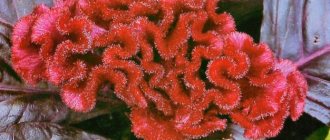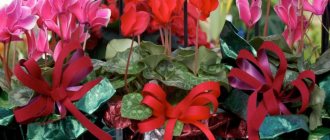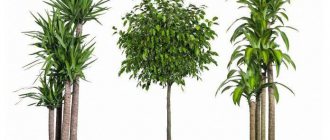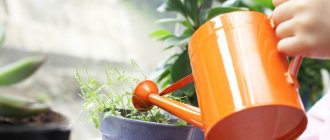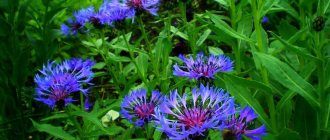Some people cannot tolerate angles in any form.
A good example is the famous round house of Pierre Cardin (Palais Bulles) in the suburbs of Cannes. But we will not delve into the particular worldview of the antagonists of this completely harmless geometric figure, but will do a much more pleasant thing: we will select such highlight plants that will support the “round theme” of the summer cottage. Gomphrena spherical will be harmonious in a round dacha, photo by the author
Why are such plants needed? After all, you can simply arrange round flower beds, place them in the middle of the lawn - and that’s it.
Round flowerbed, photo by the author
This simple win-win solution is quite common in open ground areas. Garden vases of the same shape can also support a round flower bed.
Impatiens in a round garden vase, photo by the author
But what to do when at the dacha every inch of land is worth its weight in gold, and creating a round flower bed is an unaffordable luxury? But I want to round everything off, soften it, make it more comfortable, chamber, intimate...
Leonotis - round beauties for a round dacha, photo by the author
This is where plants come to the rescue. In this area, the undisputed favorites are spherical topiary haircuts of evergreen shrubs, but we will not talk about them. Today we will look at floral perennials and annuals with spherical and hemispherical inflorescences, which during flowering (and often fruiting) will support the round concept of your dacha.
Monarda has hemispherical inflorescences visible after flowering, photo by the author
From a botanical point of view, the concepts of “spherical” and “hemispherical” are very arbitrary, since this can be a head or an umbrella, which, in turn, can be collected into complex whorled inflorescences. In some species, even a basket-shaped inflorescence with a convex hemispherical center of tubular flowers can support a “round” dacha orientation.
Echinacea purpurea with its baskets turns into the prima donna of a flower garden with round shapes, photo by the author
The role of such plants in contrasting compositions cannot be overestimated: thanks to them, shaped harmony in contrast is achieved, flower beds become more interesting.
Ads by
Curly beetle and perennial beetle
Curly beetle (Jasione crispa) and perennial beetle (J. laevis) are amazing (still rare in our dachas) rosette perennial plants from the Campanulaceae family, which in the summer will maintain a cool blue and blue color scheme in the flower garden.
Next to gray stones they will look more natural. Curly beetle, photo from alpine-seeds.com The first comes from Southern Spain, 10 cm high, 15 cm wide, inflorescences up to 2 cm in diameter.
The bukushnik is smooth. Photo from the site mnogoletniki.by
The second is a native of Western and Southern Europe, 20-30 cm high, up to 20 cm wide, inflorescences 2.5-4 cm in diameter.
In English reference literature, their winter temperature minimum is -15ºС, therefore, in central Russia, planting sites must be mulched with an organic substrate and covered with dry leaves on top.
Flowers Golden balls: growing in open ground
Flowers Golden Balls: photo
Rudbeckia does not require complex care. Even without basic proper care, she can live quite a long time. However, despite this, you should adhere to simple rules for caring for a flower.
Rudbeckias prefer well-lit areas. Before planting rudbeckia, you need to weed the ground 20-20 cm, and also clear the bed of weeds. Later, use humus or compost, as well as mineral fertilizers. Humus or compost is needed in the area of 5 kg per 1 square meter.
The best period for planting seedlings is May. The advantage of planting seedlings is that the plant blooms in the same season.
Sequence of stages of planting Golden Balls:
- Dig holes in the ground at intervals of about 40 cm.
- Place the seedling in the hole and dig in.
- Water it.
- There is no need to compact the soil.
- Until rubecia takes root, it is necessary to water it regularly.
It is also permissible to plant rudbeckia with seeds. However, the soil should not be heavy, slightly acidic or neutral. Planting the Golden Ball flower with seeds should take place in the middle of the first month of June.
The seeds of the Golden Ball flower are not deepened into the ground, they are placed in the ground at intervals of 15 cm. Sprinkle a small amount of soil on top and water generously. By autumn, small bushes of greenery should grow. Next year, in the spring, you need to plant these bushes at a distance of half a meter from each other.
There are pros and cons to planting the Golden Ball with seeds. On the one hand, this way rubekia will bloom only next year. On the other hand, it will bloom earlier than those planted with seedlings.
Gomphrena globose
The British call Gomphrena globosa globular amaranth, with which it, as a representative of the Amaranthaceae family, is actually related.
Gomphrena globulus, photo by the author In addition to the dwarf (up to 15 cm high) varieties of the 'Buddy' series, the 'Strawberry Fields' variety is interesting, 75-80 cm high, up to 30 cm wide, bright red inflorescences, up to 5 cm in diameter.
Gomphrena globulus 'Buddy White', photo by the author. Gomphrena globulus 'Strawberry Fields'. Photo from freerangestock.com
Also on the website, see the article about this amazing plant:
- Immortal beauty - gomphrena
- Sweet and modest Gomphrena globulus 'Balloons'
Combining Golden Balls with other types of plants
As we have already found out, rudbeckias are perennial plants. Planted rudbeckia will please the eye for a single year, so you need to plant rudbeckia where you do not renew the plants annually. Rudbeckia is a very beautiful flower, it is well suited for planting next to fences or walls of the house. Rudbeckia will also look beautiful next to gazebos and recreation areas, and will harmoniously combine with tall plants.
If you plant it on your site, where it is quite windy, then it is worth securing the stems of tall varieties. Rudbeckias emphasize all their beauty in combination with bouquet flowers, adding a certain charm to them. Once cut, rudbeckia flowers will delight you for a week or more. Rudbeckia is an excellent option for those who are just starting to try their hand at gardening or simply do not want to spend a lot of effort on caring for plants, but still want to have a beautiful, bright area.
Golden balls bloom for a long time, and they are extremely easy to grow, so it is not surprising that this flower is so popular among gardeners.
Flowers Golden Balls: video
Craspedia globulus
Craspedia globosa is an unusual perennial with pompom-shaped yellow inflorescences from the Asteraceae/Compositae family that is grown as an annual.
Craspedia globular. Photo from onlineplantguide.com Craspedia globular is native to distant Australia. It is 60-90 cm high and up to 12 cm wide. Inflorescences appear from August to the end of September on leafless peduncles. Decorative varieties:
- ‘Billy Buttons' – Dutch line;
- 'Drumstick' is an American series.
Craspedia globulus 'Drumstick'. Photo from amazon.co.uk. Craspedia globulus 'Billy Buttons'. Photo from seedempire.comGrown through seedlings. Sow in February, place in a bright place. Planted in open ground in May. Loves fertilizing: 2-3 times with nitrogen and 1 time with a complete complex fertilizer. Used as dried flower.
Blue flowers blooming in summer
The popular name is "catchment". Plants with beautiful flowers of different, often variegated colors. But there are wonderful and interesting colors in blue and blue tones. Blooms beautifully in both sunny and shady places. Loves moisture, but tolerates drought well. Seeds of varietal varieties must be stratified. Subsequently it reproduces by self-seeding, but does not retain varietal characteristics.
Are you lazy or busy? Choose plants that require little maintenance, destroy any plant you are in, adopt plants that don't need water or light! Between June and September large inflorescences branched out with small blue larynx flowers with a white eye. - from 1 to 1.50 m in height × 0.60 m in width. Correct clustering, branched stems, large lanceolate dark green leaves covered with stiff hairs. - The most common. For sunny mountains, dry gardens, flower meadows.
Gnome Trap
From 0.80 to 1 m, dark blue, very strong stems that do not require harvesting. In May-June there are bright blue flowers with a white eye. - from 0.05 to 0.10 m in height × 0.15-0.20 m in width. The leaves are in a rosette, narrow and linear, dark green, rough. — Suitable for dry and rocky soils, in rock gardens.
- an amazing flower that blooms all summer. Lobelia is planted very early in January-February. During the first 2 months, the flower develops very slowly, but then neat lobelia bushes will decorate your flower garden with bright blue miniature flowers.
Bugloss of Cape Town
Blue-white flowers from June to September. - 0.30 m in all directions. The leaves are narrow and rough. — Often grown in annuals, borders and massifs. Very rustic after implantation. There were a lot of bees and butterflies. Flowers are blue, pink or white.
Blue lingerie
May June. - 40 cm in height. - The shape of beautiful bunches.
Shared linen
June July.
- 1 m in height. — Cultivated for fiber and seed oil. Small soft blue flowers, very soft tone. Blooms from June to October, blue, white, pink or red. Seeds are often sold by color, without indicating the variety. - Compact clumps from 15 to 60 cm high, dense foliage covering the ground, - Very flowering plant, ideal for flowering a balcony, terrace pots or borders of arrays redone every year in the garden. It is represented by various species: tall and low, perennial and biennial plants. Blue is a very common color among bluebells.
Blooms blue. — A clump 30 cm high with flowers, the stems of which are well separated from the foliage. — Ideal for gardening and decorating a small garden composition. Blue flowers, very bright. Flowering is persistent blue, almost purple - 15 cm in height, very compact - one of the darkest, which can be used in combination with white or light pink.
Flour Sage
Long spikes of small blue, purple or white flowers depending on variety. - Deciduous foliage with downy veins on the underside, stems covered with a whitish veil, height: 0.60 m. - Perennial plant grown as an annual plant, planted against a background of massive perennials, herbs or annuals or a large container.
- an aristocrat among summer flowering plants. Despite its sophistication, it is simple and undemanding to care for; a perennial delphinium can grow in one place for 20 years. Winters well in open ground without shelter. The only thing you should pay attention to is that you should not bury the root collar of the plant when planting.
Ears of compact flowers, about 1 cm long, intense blue, from May to July, second bloom in late summer. — Bushes are vertical, dense, from 0.80 to 1 m, dark green embossed leaves. — One of the most flowery and rustic. In a massif at the base of roses or shrubs with a receding foot, with pink or white phlox.
Clivia indoor flower
Strong blue flowers. — Height: 0.40 m. — More flowering than species. Large purple-blue flowers in July-August. 'Fairy Snow' has pure white flowers streaked with blue. - Dwarf form. Height: 0.20 m. - Very long flowering. Gnome and compact shape. — Growing in a pot or in a mountain garden. The leaves of the pannatifids are cut dark green, with a silvered back, more or less sharp. Stems with little or no branching. — Capsules 3-4 cm long, well blue before flowers open, then steel blue, from July to September.
Hyssop
– drought-resistant, medicinal, light-loving shrub. Grows best in calcareous soils. An excellent honey plant, flowering time is June.
Linen
represented by annual and perennial plants. Choose a sunny place for planting. It blooms profusely, long and beautifully.
The fruit is 4-5 mm long. A gift from Spain to Siberia, Europe and Central Asia, on rocky slopes, thickets, bare and rocky soil. Spiny foliage. — Blue steel flowers, related to autumn, are very blooming. 1.20 m high by 0.80 wide. Natural style plant, easy to grow. A sturdy piece 1 to 1.50 m high. - Very large inflorescences of blue lightning 6 cm at maturity.
Blue lily, lotus of Egypt
Large floating leaves, split at the base. —Flowers are medium-sized, diurnal, solitary, fragrant, appearing largely above the foliage. Blue lavender petals, yellow stamens.
Water lily
A miniature form of blue water lily with small deferent leaves. — The flowers are also small and fragrant. Azure blue petals, purple-blue stamens and yellow anthers. From June to September. - Particularly flowering and fragrant, elegant and well marked for culture in a large tank.
,
What is a garden without irises? And now there are a lot of varieties of irises. Amazing Bearded Irises surprise with their shape and color. There are varieties with modest ordinary flowers, but with an amazing aroma. Irises are transplanted to a new location once every 3-4 years, 2 weeks after flowering.
Crushed stone with grass leaves
Large blue lavender flowers with a white heart. Blue-violet flowers. — Interesting variety in the company of plants with pale yellow flowers. Flowers in small blue or lily pompoms. Used in rock gardens. Pale blue flowers. — The fruits are 7 cm in diameter with green and brown alveolar-shaped bracts. They can be used for dry bouquets.
Eichhorn blue sky
The underwater leaves are linear, ribbed, from 6 to 20 cm long, on the contrary, they all resemble a small palm. The leaves appeared round, 4-8 cm, with long petioles. — A cluster of large light blue flowers marked with yellow, the petals are fringed and covered with many glandular hairs. — Present in the region of shallow-water planets, either embedded in the mud or floating, original and very decorative. They are found mainly in French Guiana.
Phlox. For a flowerbed with blue flowers, choose ground cover blue phlox spreading or phlox subulate with blue flowers. Phlox of these types are planted in moderately moist soil and well-lit areas. After flowering, the flowers are cut off.
– fluffy balls of blue and blue flowers will be a wonderful border in a flower garden.
Onion
Nature generously endowed alliums (Allium), representatives of the Liliaceae family, with spherical and hemispherical umbrellas:
- Maclean's onion (A. macleanii);
- l. highest (A. altissimum);
- l. giant (A. giganteum);
- l. aflatun (A. aflatunense);
- l. round-headed (A. sphaerocephalon);
- l. Karatavi (A. karataviense) and others.
Decorative bows in May, photo by the author Their shape will beautifully emphasize the “round” theme of the dacha, but you just need to choose the right place for planting decorative bows. Many of them come from steppe or mountainous regions with rocky or thin soils. They are accustomed to an abundance of sun and warmth, and to well-permeable soils. Heavy compacted soil that holds water will be detrimental to them.
Ball-headed Echinops
Echinops sphaerocephalus is another member of the Asteraceae/Compositae family with charming spherical inflorescence heads in blue, light blue and white.
It comes from Central and Southern Europe, the Caucasus, and Siberia. Echinops globulus, photo by the author Its combinations with loosestrife, catnip, foxglove, with the addition of perovskia and gypsophila, provide excellent romantic compositions. Mordovnik is charming in nuanced combinations with falaris, white-flowered aconite and cosmos. Grows best in open areas with alkaline permeable soils.
All of the perennial plants listed above can be found in our catalog, which contains offers from large online stores of seeds and planting material. Choose perennial plants.
Primula Rosella F1, Mix, 7 pcs. 87 RUR
seedspost.ru
Viola horned Sorbet HR White F1, 5 pcs. 44 rub.
seedspost.ru
Russell's Lupine Blue Flame, 0.5 g 41 RUR
seedspost.ru
Delphinium New Zealand Moning Light F1, 3 pcs. New Millenium Hybrids 210 RUR
seedspost.ru
Exotic flowers for bouquets
Exotic flowers in bouquets are increasingly used by florists. Agapanthus, heliconia, calla lilies, plumeria, strelitzia, celosia and other flowers are found in the compositions.
The most popular among all exotics are orchids . The fragile flowers of orchids, native to Central America, symbolize beauty and love. These flowers look great in any composition and can be decorated with any decorations. There are many varieties of orchids. The following flowers are used in wedding bouquets: ascocenda, vanda, dendrobium, phalaenopsis. Bouquets with orchids retain their original appearance for a long time, which makes them attractive for wedding floristry.
No less popular in floristry is the combination of various herbs, fruits and berries with flowers.
Herbs in flower bouquets
To make bouquets, not only flowers are used, but also various herbs.
The most common herbs that are added to a bouquet are represented by the following list:
Gypsophila
Gypsophila is a delicate herbaceous plant bearing a large number of small white flowers. The plant symbolizes modesty. Florists offer bouquets with gypsophila for timid and young girls and brides. Openwork flowers can not only complement any bouquet, but also look great on their own. Delightful bouquets are obtained from a combination of gypsophila with orchids, ranunculus, roses and tulips.
Feather grass
Feather grass is an elegant fluffy grass, from which florists love to create various bouquets in combination with flowers. Most often, feather grass is used to decorate dry compositions. Feather grass with dried roses or wildflowers will fit into the design of any interior. Silk feather grass spikelets can also be seen in a living bouquet. Spring and autumn wedding compositions with this grass are created in soft pastel and silver tones.
Lavender
Lavender symbolizes love and happiness. The soft lilac and purple color and pleasant aroma of the plant attract attention. Lavender is a frequent guest in wedding floristry bouquets. In Provence style weddings, the bouquet looks stylish and original.
Tansy
Tansy is a medicinal herb with golden yellow inflorescences. The plant has a camphor-like smell, so it is preferred to make dry bouquets for indoors. Dried tansy is used to make autumn and winter compositions. Live tansy looks great with various meadow flowers, especially daisies. Keep tansy bouquets on an open terrace or in a frequently ventilated room.
Forbs No less popular are rosemary , sage and other herbs.
Florists use herbs not only to dilute bouquets, but also create entire compositions from several types of herbs with flowers. Bouquets of herbs make a good addition to rural and vintage weddings.
Santolina cypressum
Santolina chamaecyparissus - a luxurious Mediterranean beauty with a height of 50 cm and a width of up to 1 m comes from the Asteraceae / Compositae family.
The bright inflorescences of Santolina behind Erica herbacea attract attention with their beauty, photo by the author. Regular pruning can turn it into a bluish ball, which during the flowering period will be decorated with a mass of yellow spherical inflorescences. For information about the preferences of Santolina, see the article website:
- Silvery herbaceous plants: garden decoration from spring to autumn
- Southern charm of lavender, rosemary and other Mediterranean
Cut flowers for bouquets
The names of flowers and their brief descriptions give novice florists an idea of popular flowers that can be used when composing bouquets.
Alstroemeria. Pleases with a rich color palette and excellent durability. When cut, they can last 3-4 weeks. Suitable for people with increased sensitivity to fragrances as they are odorless.
Anemone. The flower is called anemone for its light and delicate petals that fall off in a strong wind. The color range of anemones, similar to poppies, is varied. But most of all they like to add them to winter bouquets. The deep blue anemone looks unusual and fascinating. A frequent guest in the design of blue wedding bouquets. We even have a separate article dedicated only to blue flowers in compositions. Click here and the article will open in a new window.
Aster. This is a favorite flower in an autumn bouquet. The star-like aster is given not only to teachers, but also to beautiful women. The aster will be an interesting element in a wedding composition.
Carnation. A correctly assembled bouquet of carnations is as beautiful as bouquets of roses, which is why many florists choose delicate carnations for bridal bouquets.
Gerbera. Sunny gerbera will add brightness to any bouquet. The flowers look like colorful daisies and symbolize the joy of life. Gerberas go well with irises and orchids.
Hyacinth. Spring flowers with delicate shades that look good in pastel bouquets.
Hydrangea. The lush inflorescence of hydrangea allows you to create lovely mono-bouquets that look touching in the hands of the bride.
Iris. A bouquet of irises looks sophisticated; such a composition is an excellent birthday or anniversary gift for a woman or man.
Trachymene, or didiscus blue
Trachymene, or blue didiscus (Trachymene caerulea, syn. Didiscus caeruleus) is an interesting annual from the Umbrella family (Apiaceae/Umbelliferae), up to 60 cm high and 23 cm wide. Blue didiscus.
Photo from pbase.com Small lavender-blue flowers with a pleasant subtle aroma are collected in dense spherical umbrellas with a diameter of up to 5 cm. It blooms in open sunny places from late June until late autumn frosts. Seedlings are sown from late March to mid-April. They are planted in open ground at the end of May, when the threat of return frosts has passed, keeping a distance of 20-25 cm between plants.
Berries in flower bouquets
When making bouquets, berries are added in summer and autumn during the growth or ripening of fruits. In summer bouquets, unripe fruits are popular, which will not stain the bride’s dress, and in autumn, hard fruits of bushes and trees are popular.
In summer floristry you can find blackberries, strawberries, raspberries, and St. John's wort. Fruits in autumn floristry have the same names, like shrubs and trees - hawthorn, viburnum, rowan, rose hip. Many of these berries can be added to bouquets year-round.
Let's look at the description of some berries in more detail.
Blackberries and raspberries
Blackberries and raspberries have an interesting shape. The refreshing appearance and sweet aroma of berries will be a pleasant addition to any bouquet. Blackberries and raspberries symbolize wealth and happiness, which is why they are popular in wedding floristry.
Please note that in this case, blackberries and raspberries have only a decorative meaning in the bouquet, unlike edible bouquets. We wrote about them here (opens in a new window). Fruit and vegetable floristry involves practicality, when the fruits, berries or vegetables used in the bouquet can be eaten within 1-2 days.
St. John's wort
St. John's wort or Hypericum is a medicinal plant with bright yellow flowers. But the fruits of the plant are popular in bouquets. Bright red St. John's wort berries fit delightfully into bouquets with irises, callas, sunflowers and roses. The unripe fruits of white, green and yellow shades of St. John's wort are suitable for creating romantic bouquets.
Kalina
Red viburnum has long been a decoration for weddings. Viburnum branches were hung indoors and placed on the table, and added to the bride’s bouquet. Nowadays, florists add viburnum to bouquets, emphasizing the charm of the bride. In bouquets, viburnum goes well with gerberas, callas, poppies, and roses.
Strawberry
Fragrant strawberries in a flower arrangement symbolize fertility. When adding to a bouquet, choose dense and slightly unripe berries. Strawberries go well with flowers in pastel shades, but you can also add bright plants such as lilies, roses, and eustomas.
Rowan
Orange or red rowan berries look great in an autumn bouquet, either as a gift or for the bride. Rowan berry clusters can be added to any floral arrangement, but they look more interesting in bouquets of white, burgundy, orange and purple flowers.
Cephalophora aromatica
Thanks to its amazing berry aroma, the perennial aromatic cephalophora (Cephalophora aromatica) from the Asteraceae/Compositae family is rapidly gaining popularity. In central Russia it is grown as an annual.
Cephalophora is aromatic. Photo from the website botanichka.ru Not long ago, seeds of the 'Pineapple Dessert' variety appeared on sale. For information on how to grow it, see the commentary on the question:
- How to sow and grow cephalophora correctly?
